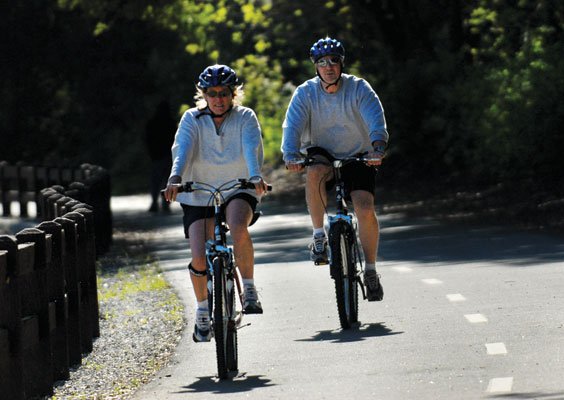State budget cuts mean Gilroy will have to wait for $1.6 million
in grant money to come down the pipeline, but when it does, the
city’s nascent trail system will leap toward, and residents will
begin to see the fruits of meticulous planning.
State budget cuts mean Gilroy will have to wait for $1.6 million in grant money to come down the pipeline, but when it does, the city’s nascent trail system will leap toward, and residents will begin to see the fruits of meticulous planning.
That’s because Gilroy is armed with an 111-page document detailing a 43-mile network of more than 60 trails that will one day wind through the city and beyond. With most state grant money frozen, though, the projects have been put on hold unless the city wants to dip into its shrinking reserve and then await reimbursement from Sacramento. Complete buildout of Gilroy’s elaborate paths will cost about $51.7 million, plus an additional $500,000 a year to maintain, according to GIlroy’s Trails Master Plan, which does not have a specific time frame.
That plan envisions trails circling the city, following creeks along the south and east, connecting schools, parks and offices and traversing ridgelines toward Santa Cruz and up into the rest of the Bay Area. Waterways abutting the trails include the Llagas Creek, Lions Creek, Ronan Channel, Morey Channel and Uvas Creek. In 2006, state officials awarded Gilroy more than $1 million to add a trail along Uvas Creek – a year after the city council approved Gilroy’s intricate plan.
“This is definitely something we can toot our horn about,” Parks & Landscape Operations Supervisor Bill Headley said of the lengthy plan. “State officials use Gilroy’s master plan to show off as a model.”
The document itself complements the city’s Parks and Recreation Systems Master Plan and aims to connect the city’s on-street bikeways and sidewalks with its parks, schools, employment centers and other destinations winding throughout the city. Together, the “visioning” documents guide Gilroy’s development and serve as detailed blueprints for grant-seekers as a sort of guarantee that the money will be well spent.
The $1 million comes from the California River Parkways Program, which will reimburse the city after it completes the first northern link in Gilroy’s trail system, known as the Lions Creek Trail. About $520,000 of the money will fund a nearly one-mile trail extension along Uvas Creek – already a magnet for hikers and joggers who love hugging the banks of that scenic waterway – from Santa Teresa Boulevard down into the ranch site facing Christmas Hill Park.
The rest of the money will create a quarter-mile trail connecting Antonio Del Buono Elementary School to Lion’s Creek near Wren Avenue in north Gilroy. Continuing that path from Wren Avenue on to Kern Avenue relies on an additional $640,000 that City Transportation Engineer Don Dey recently secured from the state, according to Headley.
Of course, all $1.6 million in rebate money is frozen for now, Headley said, and the city also has its own financial problems, including a nearly $3 million deficit in the public facilities capital improvement fund. That fund will eventually pay for the trails with fees from developers when they start building houses again. Some developments such as Glen Loma along Santa Teresa Boulevard across from Eagle Ridge, will incorporate trails within their subdivisions that will link up with the city’s trails.
While all this means the trail system has been put on hold, Gilroy will be more than ready when things turn around, Headley said.
That’s thanks to the 17 community members and various officials who sat on the task force between 2003 and 2005 and worked with professional planners and park savvy professionals for more than a year to generate the prized document. Without the plan, Gilroy would not have had a chance at pulling down the grants, according to Lee Steinmetz, principal of Bellinger Foster & Steinmetz, whose landscape architecture firm helped the city craft the document and apply for grants.
“Having a master plan is really a critical element and the document will definitely pay for itself in terms of the grant money the city will receive,” Steinmetz said, adding that Gilroy’s particular plan is auspicious and a true signature of the community.
“What’s really great about the Gilroy plan is it involved beauty in the development, and representatives from the community along with county officials and people from the (Santa Clara Valley Water District) offered their input,” said Steinmetz, a 25-year professional.
The Juan Bautista de Anza National Historic Trail, which runs from Mexico to San Francisco, will link up with Gilroy’s eventual network. While most of Gilroy’s planned trails are designed for pedestrians and bikers, a proposed trail along Llagas Creek and Holsclaw Road will accommodate not only cyclists and amblers, but also horses to comply with the guidelines for the national path. That route commemorates the one de Anza took between 1775 and 1776 when he led a colonial expedition from what is now Horcasitas, Sonora, Mexico, to the San Francisco Bay. The travelers crossed what is now Santa Clara County three times.
The 43-plus miles of walkways will also intersect the planned southern tip of the Bay Area Ridge Trail at a yet-to-be-determined location. That trail, which has disconnected elements near Mt. Madonna and Coyote Lake, generally follows the ridges and mountains that surround the San Francisco Bay, connecting nine Bay Area counties. One day the Bay Area Ridge trail will cross the Santa Clara Valley through or near Gilroy, according to the trails master plan.
HOW MUCH DOES A TRAIL COST?
Pedestrian Only Trail: $20 per lineal foot or $105,600 per mile.
Pedestrian/Bike Trail: $120 per lineal foot or $633,600 per mile.
Pedestrian/Bike/Equestrian Trail : $120 per lineal foot or $633,600 per mile.
Source: Gilroy Trails Master Plan, May 2005
WHO WORKED ON THE PLAN?
Sherri Stuart, Norm Thompson, Doug Meier, Steve Nelson, Edith Edde, John Donahoe, Pedro Pornalas, John Hewitt, Pam Gimenez, Ty Ashford, Charles Van Meter, Brian Mendenhall, Carol Frederickson, Gretchen Yoder-Schrock, Art Kerr, Thomas Muniz, Bob Eltgroth















